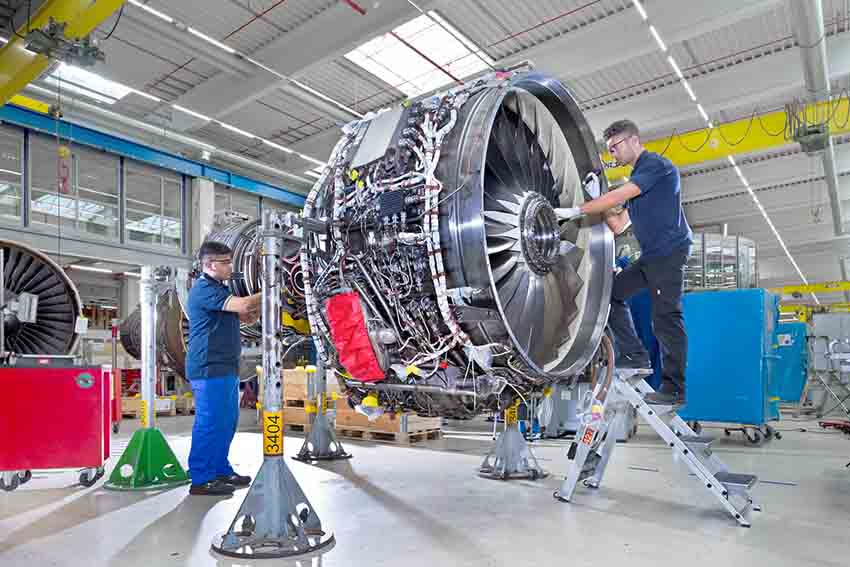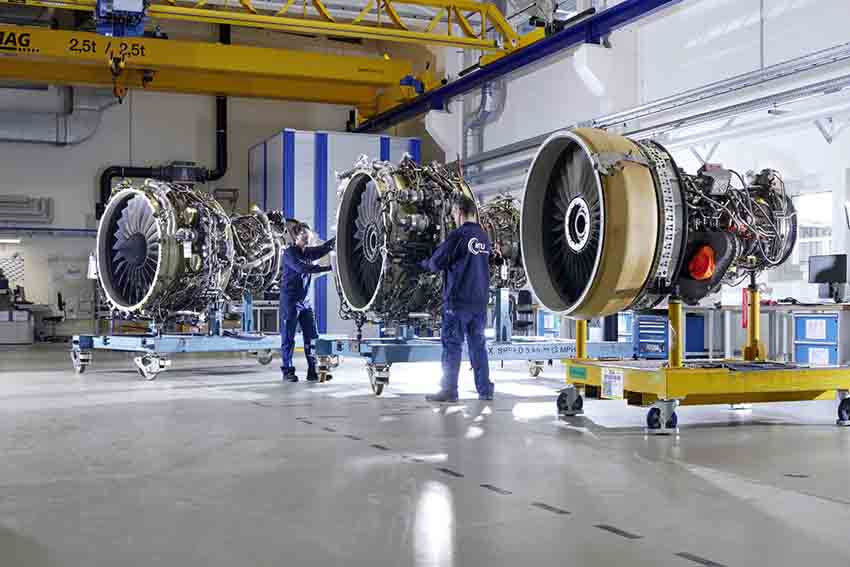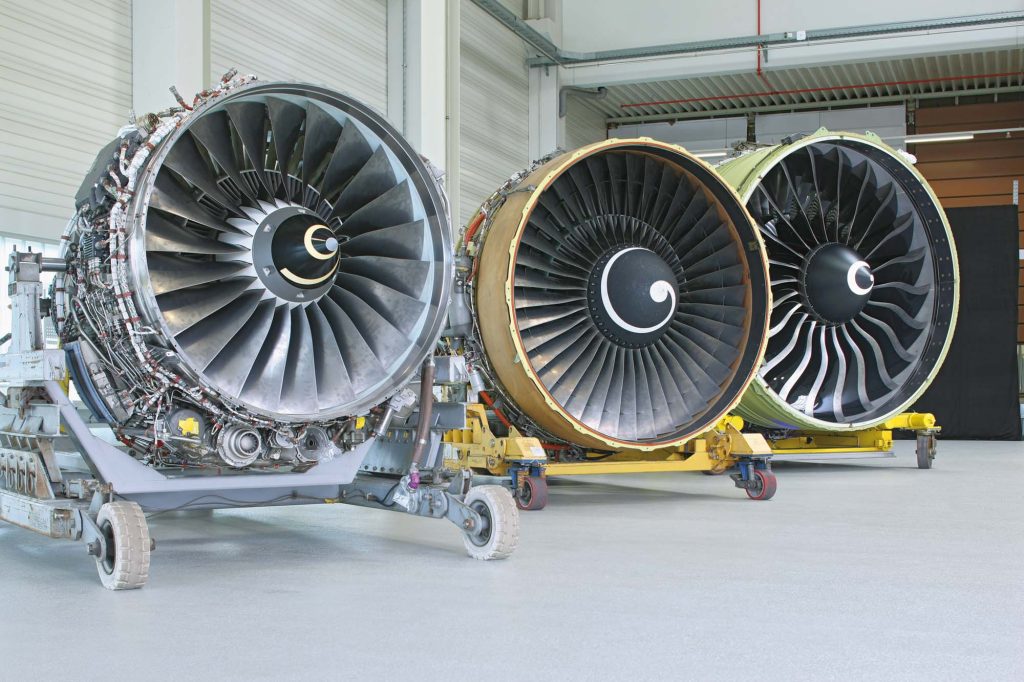MTU Maintenance is a business division of MTU Aero Engines and specializes in the maintenance, repair and overhaul (MRO) of aero engines, as well as in integrated engine leasing and asset management. As the global market leader in customized solutions for aero engines, MTU Maintenance boasts a portfolio of more than 30 engines and has locations in Europe, Asia, Australia, and North and South America.
The company currently emploies roughly 5,500 engine experts worldwide and conduct about 1,200 engine shop visits annually for more than 270 airline customers. In its more than 40-year history, MTU Maintenance has performed over 22,000 shop visits and offers extensive support to customers by combining engineering expertise, in-depth market understanding and robust financial strength. MTU is certified by the Federal Aviation Administration, the European Union Aviation Safety Authority and the Civil Aviation Administration of China, and has over 50 country-specific certifications throughout their network.
Interview with Martin Friis-Petersen, Senior VP MRO Programs at MTU Aero Engines.
Easy Engineering: What are the main areas of activity of the company?
Martin Friis-Petersen: Our main activity is and remains engine MRO, although we have over time developed many additional services around our core business. We use a holistic approach to engine maintenance. MTU’s central aim for its customers and partners is to optimize the cost of ownership of their assets, whether that is for a single engine or an entire fleet across the lifecycle. That means, our global network has the capabilities to react to any need, from full-fledged shop visits for an overhaul, to surgical events or repairs conducted on- and near-wing at a hangar, or providing an exchange or lease engine instead of MRO, if that makes more economical sense! Our services cover just about any situation and we offer complete solutions. This includes spare engine leasing to cover any intermediate periods while an engine is serviced at one of our locations, as well as engine trend monitoring to keep an eye on performance and to stay ahead of potential technical issues, or teardown and end-of-life management of the asset, just to name a few.
Thanks to our vast in-house component repair and engine teardown capabilities as well as our used serviceable parts sourcing strategy, we rely less on new parts than some of our competitors. This makes MTU extraordinarily agile and cost-effective as a service provider.
Within our portfolio, we cover engines of every size and type, from the GE90-110/-115B, the largest engine worldwide and used on wide-body aircraft for intercontinental routes, to CFM56, V2500, and CF34 for narrow-body and regional aircraft on shorter routes. Of course, our portfolio also includes newer generation engines such as CFM International’s LEAP and Pratt & Whitney’s GTFTM. In addition, we offer MRO services for business jet and helicopter engines. Under our MTU Power brand, we also cover industrial gas turbines, which are aero engine derivatives and used for power generation in gas and oil industry, as well as on marine vessels and in civic energy infrastructure.

E.E: What’s the news about new products?
M.F.P: The last product we launched was CORTEX, our AI-assisted maintenance optimization software, so we have been largely focused on digitalizing parts of our MRO operations.
E.E: What are the ranges of products?
M.F.P: In order to offer services specifically tailored to the needs of engine operators and owners, we have come up with a cluster of four intelligent solutions, which help control and optimize costs and maximize residual value.
For operators of newer engines, MTU’s PERFORMPlus solution aims at generating more flight hours with intelligent fleet management that optimizes removals across a defined period. To achieve that, we use predictive maintenance based on engine trend monitoring, ON-SITEPlus services and spare engine support.
As engines start maturing, we recommend SAVEPlus, which includes alternative MRO solutions, such as smart repairs and tailored workscopes to suit operators’ remaining flight periods, as well as material salvation and intelligent teardowns. These services can be combined with leasing in of green-time engines or exchanging engines for the remainder until phase-out.
For engines that are powering aircraft close to or at the end of life, we have VALUEPlus. Our effective end-of-life asset management ensures engine owners can get the most value out of their engines and the best exit strategy for the asset. This can range from generating additional income through green-time lease-out to sale, exchange and trade, all the way to maximizing the material value of the asset through teardown and material management.
With MOVEPlus, we support customers with a portable MRO solution across the lifecycle, enabling fast re-marketability of assets through easy transfers and predictable costs with no unnecessary MRO work. Services can start from the moment the engine is purchased, or at any point in the lifecycle. Aircraft lessors are directly involved in engine maintenance decisions – particularly during transitions between lessees, in managing and optimizing maintenance reserves, and choosing the timing of engine shop visits. Our solution also includes intelligent end-of-life strategies and extensive technical consultancy. Both lessors and lessees benefit from our comprehensive, cost-effective MRO services, simplified transitions, and ultimately, financial and technical risk mitigation.
In addition to our fully integrated solutions, we also offer SERVICEPlus, a series of additional and individual services. These range from single MRO events, component repairs and on-site and near-wing services, to complementary services such as technical asset management, line replaceable units management and engine trend monitoring. All of these can be provided on an ad-hoc basis or combined as part of a customized solution.

E.E: At what stage is the market where you are currently active?
M.F.P: The market has just come out of the pandemic and engine flight hours are running at about 94% of 2019 levels, according to IATA, so that is the good news. The MRO industry is very much back, but there are some headaches with respect to the supply chain and personnel bottlenecks.
Skilled and experienced workforce shortage will be around for some time mirroring the demographic development – especially in the Western World. This is an industry-wide challenge that we all need to address proactively. There are even some companies that are struggling to retain their new hires today. MTU was fortunate enough to retain its workforce during COVID and we are partnering with schools, colleges and universities to recruit and train new hires on a continual basis – all over the world. We will continue to invest into our in-house mechanic apprentice programs and training centers.
This coincides with a high-demand market for aero engine materials throughout – for new material, repaired parts as well as used parts, the latter being very scarce and at a historic low at present due to the low level of aircraft retirements.
We have been seeing some improvements during the past months. Also, we believe that MTU may be less affected than others by parts shortages, as we have been replenishing our parts stocks by purchasing engines for teardown — and did so well ahead of the recovery – as well as repairing a high share of parts in-house. This in combination with a close alignment with our customer base on scheduling and forecasting enables us to better prepare for upcoming shop visit volume.
That said, an engine consists of thousands of parts and one missing critical part, or even a missing minor part, can result in a work stoppage. So the situation remains challenging.
E.E: What are the most innovative products marketed?
M.F.P: MTU Maintenance uses a number of digital tools in its MRO processes and offers digital maintenance services, most prominently CORTEX and Engine Trend Monitoring (ETM), our proprietary software programs which are used for data processing and analysis, and maintenance planning either for single engines or entire fleets.
CORTEX analyses technical, commercial and market data to generate tailor-made maintenance strategies for customers. Using AI optimization algorithms and taking into account a multitude of variable parameters, such as utilization, operational conditions, parts availability, cost structures and engine health, the software produces cost-optimized MRO scenarios. These results are then discussed by our experts with each customer to find the best solution.
For a given contract period and type, the tool is able to forecast material needs down to a life-limited part (LLP) level, comply with configuration requirements and can calculate spare engine requirements to cover the respective MRO intervals. Thanks to CORTEX, the customer then knows how much on-wing time is left and what the residual value of their assets will be at the end of the lifecycle. We leave nothing to chance and seek out all possible factors that could save the engine operator maintenance costs.

ETM collects engine performance and other operational parameters recorded during the flight, processes them with our proprietary physics-based models and continually updates the customer on the latest condition of their assets. ETM is offered in conjunction with our MRO services as well as a stand-alone service as a means to increase efficiency and lower the operating cost of an engine through advanced diagnosis, analysis and prognosis.
The system observes fuel flow, exhaust gas temperature, shaft speeds and other metrics. If there are abnormalities in the values, it sends an alert to a platform that is fully accessible via any smart device. Our experts in engineering then analyze the deviations and make recommendations about a course of action, helping our customers to avoid operational disruptions.
E.E: What estimations do you have for 2023?
M.F.P: On a global perspective, we expect estimated 2023 revenues for the MRO market to be in the range of $40-$41 billion, which is in line with most independent industry forecasts.
We expect pent-up demand to last for another 1-2 years, partly due to limited MRO capacity and longer turnaround times than pre-COVID 2019. This affects very mature engines, where spare and exchange green-time engines in specific configurations as well as used serviceable material are very rare and there is no alternative to MRO for now.
Aging popular narrow-body engines are experiencing a strong demand, too, as many V2500 and CFM56-5B/7B have not even had their first shop visits yet. At the same time though, older models or configurations of these popular engines are coming under pressure due to increasing overhaul costs driven by LLPs. On the other hand, delays in new aircraft deliveries may force airlines to keep flying aircraft, that were originally planned to be retired or returned to the lessor soon, for a longer period of time. This may result in engines requiring an additional shop visit to extend their lives to their revised retirement or lease return date.

